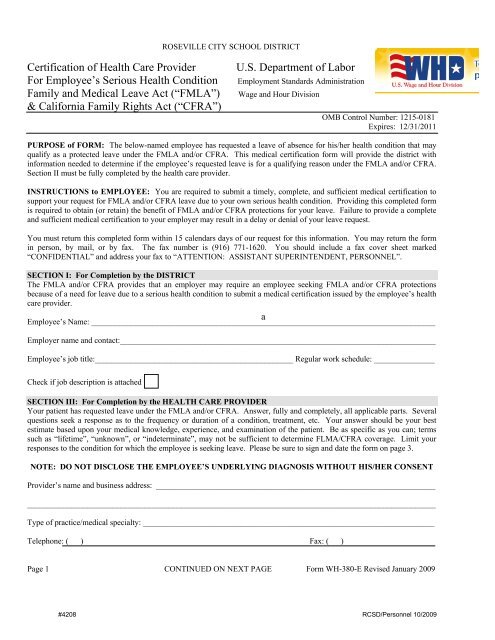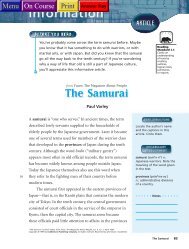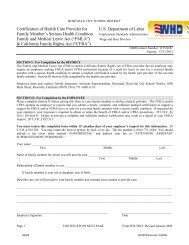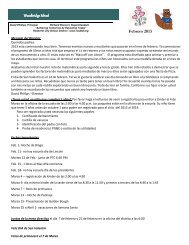WH 380E Certification of Health Care Provider No 4208
WH 380E Certification of Health Care Provider No 4208
WH 380E Certification of Health Care Provider No 4208
You also want an ePaper? Increase the reach of your titles
YUMPU automatically turns print PDFs into web optimized ePapers that Google loves.
ROSEVILLE CITY SCHOOL DISTRICT<strong>Certification</strong> <strong>of</strong> <strong>Health</strong> <strong>Care</strong> <strong>Provider</strong>For Employee’s Serious <strong>Health</strong> ConditionFamily and Medical Leave Act (“FMLA”)& California Family Rights Act (“CFRA”)U.S. Department <strong>of</strong> LaborEmployment Standards AdministrationWage and Hour DivisionOMB Control Number: 1215-0181Expires: 12/31/2011PURPOSE <strong>of</strong> FORM: The below-named employee has requested a leave <strong>of</strong> absence for his/her health condition that mayqualify as a protected leave under the FMLA and/or CFRA. This medical certification form will provide the district withinformation needed to determine if the employee’s requested leave is for a qualifying reason under the FMLA and/or CFRA.Section II must be fully completed by the health care provider.INSTRUCTIONS to EMPLOYEE: You are required to submit a timely, complete, and sufficient medical certification tosupport your request for FMLA and/or CFRA leave due to your own serious health condition. Providing this completed formis required to obtain (or retain) the benefit <strong>of</strong> FMLA and/or CFRA protections for your leave. Failure to provide a completeand sufficient medical certification to your employer may result in a delay or denial <strong>of</strong> your leave request.You must return this completed form within 15 calendars days <strong>of</strong> our request for this information. You may return the formin person, by mail, or by fax. The fax number is (916) 771-1620. You should include a fax cover sheet marked“CONFIDENTIAL” and address your fax to “ATTENTION: ASSISTANT SUPERINTENDENT, PERSONNEL”.SECTION I: For Completion by the DISTRICTThe FMLA and/or CFRA provides that an employer may require an employee seeking FMLA and/or CFRA protectionsbecause <strong>of</strong> a need for leave due to a serious health condition to submit a medical certification issued by the employee’s healthcare provider.Employee’s Name: _____________________________________________________________________________________Employer name and contact:______________________________________________________________________________Employee’s job title:_________________________________________________ Regular work schedule: _______________Check if job description is attached □SECTION III: For Completion by the HEALTH CARE PROVIDERYour patient has requested leave under the FMLA and/or CFRA. Answer, fully and completely, all applicable parts. Severalquestions seek a response as to the frequency or duration <strong>of</strong> a condition, treatment, etc. Your answer should be your bestestimate based upon your medical knowledge, experience, and examination <strong>of</strong> the patient. Be as specific as you can; termssuch as “lifetime”, “unknown”, or “indeterminate”, may not be sufficient to determine FLMA/CFRA coverage. Limit yourresponses to the condition for which the employee is seeking leave. Please be sure to sign and date the form on page 3.NOTE: DO NOT DISCLOSE THE EMPLOYEE’S UNDERLYING DIAGNOSIS WITHOUT HIS/HER CONSENT<strong>Provider</strong>’s name and business address: __________________________________________________________________________________________________________________________________________________________________________Type <strong>of</strong> practice/medical specialty: ________________________________________________________________________Telephone: ( ) Fax: ( )Page 1 CONTINUED ON NEXT PAGE Form <strong>WH</strong>-380-E Revised January 2009#<strong>4208</strong> RCSD/Personnel 10/2009
PART A: MEDICAL FACTS1. Appropriate date condition commenced: __________________________________________________________________Probable duration <strong>of</strong> condition: _________________________________________________________________________Mark below as applicable:Was the patient admitted for an overnight stay in a hospital, hospice, or residential medical care facility?□ <strong>No</strong> □ Yes If so, dates <strong>of</strong> admission: ______________________________________________________________Date(s) you treated the patient for condition: ______________________________________________________________Will the patient need to have treatment visits at least twice per year due to the condition?Was medication, other than over-the-counter medication, prescribed?Was the patient referred to other health care provider(s) for evaluation or treatment (e.g.,physical therapist)?□ <strong>No</strong> □ Yes□ <strong>No</strong> □ Yes□ <strong>No</strong> □ YesIf so, state the nature <strong>of</strong> such treatments and expected duration <strong>of</strong> treatment: _______________________________________________________________________________________________________________________________________2. Page 4 describes what is meant by a “serious health condition” under both the FMLA and CFRA. Does the employee’scondition qualify as one <strong>of</strong> the types <strong>of</strong> health conditions described?□ <strong>No</strong> □ YesIf yes, which type <strong>of</strong> serious health condition listed on page 4 applies: □ 1 □ 2 □ 3 □ 4 □ 5 □ 6For FMLA purposes only:If the employee’s serious health condition is type 2 (as defined on page 4), did the employee visit a health care providerwithin 7 days <strong>of</strong> his/her first day <strong>of</strong> incapacity?□ <strong>No</strong> □ Yes3. Is the medical condition pregnancy? □ <strong>No</strong> □ YesIf so, expected delivery date: _____________________________4. Use the information provided by the employer in Section I to answer this question. If a list <strong>of</strong> the employee’s essentialfunctions or a job description is not attached, please answer these questions based upon the employee’s own description <strong>of</strong>his/her job functions.□ <strong>No</strong> □ YesIs the employee unable to perform any <strong>of</strong> his/her job functions due to the condition:If so, identify the job functions the employee is unable to perform.___________________________________________________________________________________________________5. Describe other relevant medical facts, if any, related to the condition for which the employee seeks leave (such medicalfacts may include symptoms, diagnosis, or any regimen <strong>of</strong> continuing treatment such as the use <strong>of</strong> specialized equipment):__________________________________________________________________________________________________________________________________________________________________________________________________________________________________________________________________________________________________________________________________________________________________________________________________________________________________________________________________________________________________________________________________________________________________________________________________________________Page 2 CONTINUED ON NEXT PAGE Form <strong>WH</strong>-380-E Revised January 2009#<strong>4208</strong> RCSD/Personnel 10/2009
Serious <strong>Health</strong> ConditionsA “serious health condition” means an illness, injury, impairment, or physical or mental condition that involvesone <strong>of</strong> the following:1. Impatient <strong>Care</strong>Impatient care (i.e., an overnight stay) in a hospital, hospice, or residential medical care facility, including anyperiod <strong>of</strong> incapacity or subsequent treatment in connection with or consequent to such inpatient care.2. Incapacity <strong>of</strong> More Than 3 Consecutive Days Plus Continuing Treatment by a <strong>Health</strong> <strong>Care</strong> <strong>Provider</strong>A period <strong>of</strong> incapacity <strong>of</strong> more than three consecutive calendar days (including any subsequent treatment orperiod <strong>of</strong> incapacity relating to the same condition), that also involves:(a)(b)Treatment two or more times by a health care provider, by a nurse or physician’s assistant underdirect supervision <strong>of</strong> a health care provider, or by a provider <strong>of</strong> health care services (e.g., physicaltherapist) under orders <strong>of</strong>, or on referral by, a health care provider; ORTreatment by a health care provider on at least one occasion which results in a regimen <strong>of</strong>continuing treatment under the supervision <strong>of</strong> the health care provider (e.g., a course <strong>of</strong>prescription medication, or therapy requiring special equipment, to resolve or alleviate the healthcondition). <strong>No</strong>te: This does not include taking over-the-counter medications or activities that canbe initiated without a visit to a health care provider (e.g., bed rest, exercise, drinking fluids).3. PregnancyA period <strong>of</strong> incapacity due to pregnancy, childbirth, or related medical conditions. This includes severemorning sickness and prenatal care. (Covered under the FMLA only)4. Chronic Conditions Requiring TreatmentA chronic condition which:(a)(b)(c)Requires periodic visits for treatment by a health care provider, or by a nurse or physician’sassistant under direct supervision <strong>of</strong> a health care provider;Continues over an extended period <strong>of</strong> time (including recurring episodes <strong>of</strong> a single underlyingcondition); andMay cause episodic rather than a continuing period <strong>of</strong> incapacity (e.g., asthma, diabetes, epilepsy,etc.).5. Permanent/Long-Term Conditions Requiring SupervisionA period <strong>of</strong> incapacity that is permanent or long-term due to a condition for which treatment may not beeffective. The employee or family member must be under the condition <strong>of</strong>, but need not be receiving activetreatment by, a health care provider. Examples include Alzheimer’s, a severe stroke, or the terminal stages <strong>of</strong>a disease.6. Multiple Treatments (<strong>No</strong>n-Chronic Conditions)Any period <strong>of</strong> absence to receive multiple treatments (including any period <strong>of</strong> recovery therefrom) by a healthcare provider or by a provider <strong>of</strong> health care services under orders <strong>of</strong>, or on referral by, a health care provider,either for restorative surgery after an accident or other injury, or for a condition that would likely result in aperiod <strong>of</strong> incapacity <strong>of</strong> more than three consecutive calendar days in the absence <strong>of</strong> medical intervention ortreatment, such as cancer (chemotherapy, radiation, etc.), severe arthritis (physical therapy), kidney disease(dialysis).Page 4CONTINUED ON NEXT PAGE#<strong>4208</strong> RCSD/Personnel 10/2009
Basic Leave EntitlementFMLA requires covered employers to provide up to 12 weeks <strong>of</strong> unpaid,job-protected leave to eligible employees for the following reasons:EMPLOYEE RIGHTS AND RESPONSIBILITIESUNDER THE FAMILY AND MEDICAL LEAVE ACTFor incapacity due to pregnancy, prenatal medical care <strong>of</strong> childbirth;To care for the employee’s child after birth, or placement foradoption or foster care;To care for the employee’s spouse, son or daughter, or parent,who has a serious health condition; orFor a serious health condition that makes the employee unable toperform the employee’s job.Military Family Leave EntitlementsEligible employees with a spouse, son, daughter, or parent on active dutyor call to active duty status in the National Guard or Reserves in support <strong>of</strong>a contingency operation may use their 12-week leave entitlement toaddress certain qualifying exigencies. Qualifying exigencies may includeattending certain military events, arranging for alternative childcare,addressing certain financial and legal arrangements, attending certaincounseling sessions, and attending post-deployment reintegrationbriefings.FMLA also includes a special leave entitlement that permits eligibleemployees to take up to 26 weeks <strong>of</strong> leave to care for a coveredservicemember during a single 12-month period. A coveredservicemember is a current member <strong>of</strong> the Armed Forces, including amember <strong>of</strong> the National Guard or Reserves, who has a serious injury orillness incurred in the line <strong>of</strong> duty on active duty that may render theservicemember medically unfit to perform his or her duties for which theservicemember is undergoing medical treatment, recuperation, or therapy;or is in outpatient status; or is on the temporary disability retired list.Benefits and ProtectionsDuring FMLA leave, the employer must maintain the employee’s healthcoverage under any “group health plan” on the same terms as if theemployee has continued to work. Upon return from FMLA leave, mostemployees must be restored to their original or equivalent positions withequivalent pay, benefits, and other employment terms.Use <strong>of</strong> FMLA leave cannot result in the loss <strong>of</strong> any employment benefitthat accrued prior to the start <strong>of</strong> an employee’s leave.Eligibility RequirementsEmployees are eligible if they have worked for a covered employer for atleast one year, for 1,250 hours over the previous 12 months, and if at least50 employees are employed by the employer within 75 miles.Definition <strong>of</strong> Serious <strong>Health</strong> ConditionA serious health condition is an illness, injury, impairment, or physical ormental condition that involves either an overnight stay in a medical carefacility, or continuing treatment by a health care provider for a conditionthat either prevents the employee from performing the functions <strong>of</strong> theemployee’s job, or prevents the qualified family member fromparticipating in school or other daily activities.Subject to certain conditions, the continuing treatment requirement may bemet by a period <strong>of</strong> incapacity <strong>of</strong> more than 3 consecutive calendar dayscombined with at least two visits to a health care provider or one visit anda regimen <strong>of</strong> continuing treatment, or incapacity due to pregnancy, orincapacity due to a chronic condition. Other conditions may meet thedefinition <strong>of</strong> continuing treatment.Use <strong>of</strong> LeaveAn employee does not need to use this leave entitlement in one block.Leave can be taken intermittently or on a reduced leave schedule whenmedically necessary. Employees must make reasonable efforts toschedule leave for planned medical treatment so as not to unduly disruptthe employer’s operations. Leave due to qualifying exigencies may alsobe taken on an intermittent basis.For additional information:For additional information:1-866-4US-WAGE (1-866-487-9243) TTY:1-866-4US-WAGE1-877-889-5627(1-866-487-9243) TTY: 1-877-889-5627WWW.WAGEHOUR.DOL.GOVWWW.WAGEHOUR.DOL.GOVU.S. Department <strong>of</strong> Labor│Employment StandardsU.S. DepartmentAdministration│<strong>of</strong> Labor│Employment Standards Administration│Wage and Hour DivisionSubstitution <strong>of</strong> Paid Leave for Unpaid LeaveEmployees ay choose or employers may require use <strong>of</strong> accrued paid leavewhile taking FMLA leave. In order to use paid leave for FMLA leave,employees must comply with the employer’s normal paid leave policies.Employee ResponsibilitiesEmployees must provide 30 days advance notice <strong>of</strong> the need to takeFMLA leave when the need is foreseeable. When 30 days notice is notpossible, the employee must provide notice as soon as practicable andgenerally must comply with an employer’s normal call-in procedures.Employees must provide sufficient information for the employer todetermine if the leave may qualify for FMLA protection and theanticipated timing and duration <strong>of</strong> the leave. Sufficient information mayinclude that the employee is unable to perform job functions, the familymember is unable to perform daily activities, the need for hospitalizationor continuing treatment by a health care provider, or circumstancessupporting the need for military family leave. Employees also mustinform the employer if the requested leave is for a reason for whichFMLA leave was previously taken or certified. Employees also may berequired to provide a certification and periodic recertification supportingthe need for leave.Employer ResponsibilitiesCovered employers must inform employees requesting leave whether theyare eligible under FMLA. If they are, the notice must specify anyadditional information required as well as the employees’ right andresponsibilities. If they are not eligible, the employer must provide areason for the ineligibility.Covered employers must inform employees if leave will be designated asFMLA-protected and the amount <strong>of</strong> leave counted against the employee’sleave entitlement. If the employer determines that the leave is not FMLAprotected,the employer must notify the employee.Unlawful Acts by EmployersFMLA makes it unlawful for any employer to: Interfere with, restrain, or deny the exercise <strong>of</strong> any rightprovided under FMLA; Discharge or discriminate against any person for opposing anypractice made unlawful by FMLA or for involvement in anyproceeding under or relating to FMLA.EnforcementAn employee may file a complaint with the U.S. Department <strong>of</strong> Labor ormay bring a private lawsuit against an employer.FMLA does not affect any Federal or State law prohibiting discrimination,or supersede any State or local law or collective bargaining agreementwhich provides greater family or medical leave rights.FMLA section 109 (29 U.S.C. § 2619) requires FMLA coveredemployers to post the text <strong>of</strong> this notice. Regulations 29 C.F.R. §825.300(a) may require additional disclosures.Wage and Hour DivisionPage 5 <strong>WH</strong>D Publication 1420 Revised January 2009#<strong>4208</strong> RCSD/Personnel 10/2009














